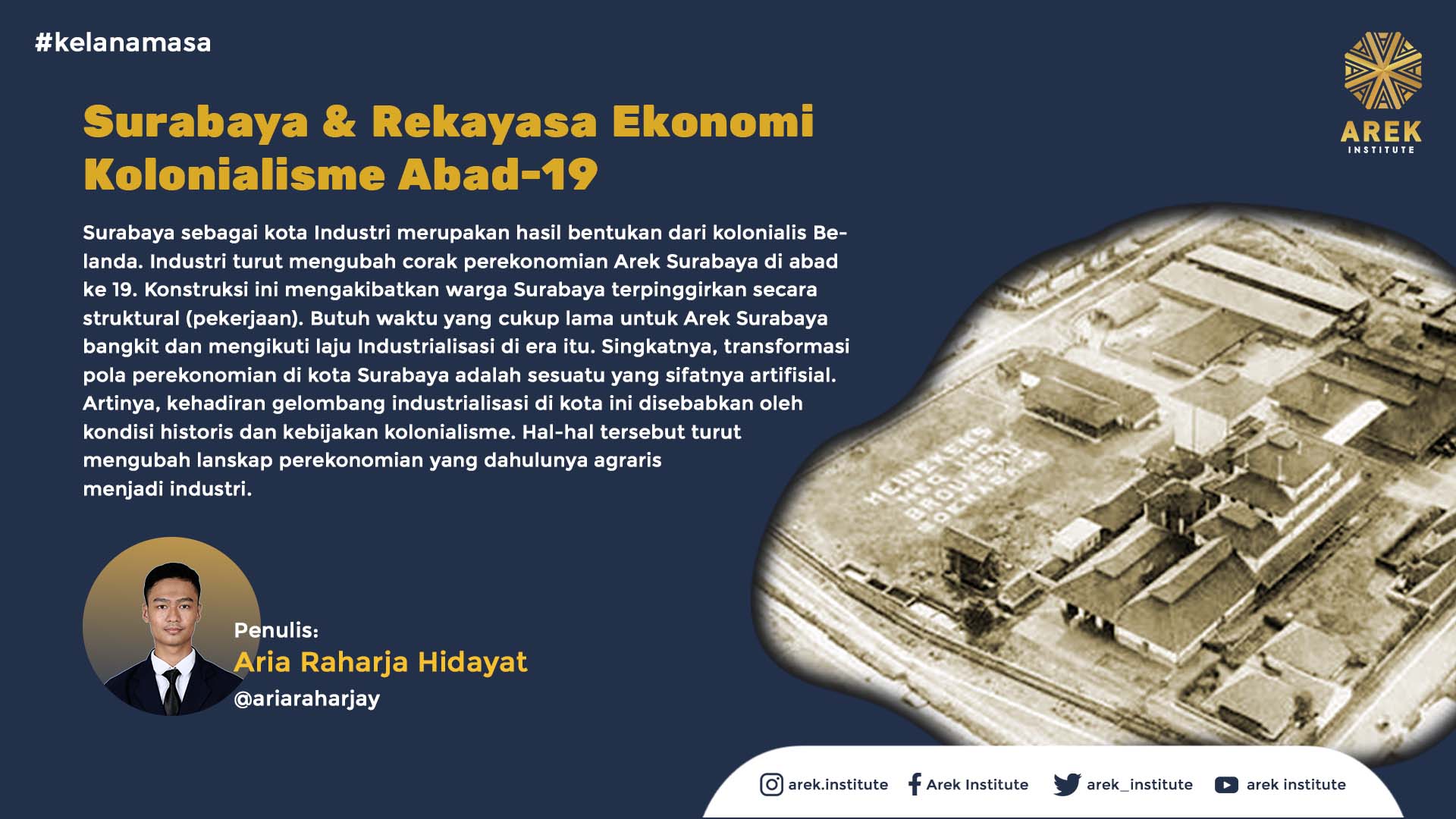
The Colonial Economy in Surabaya

Surabaya, known as an industrial city, is a result of Dutch colonial formation. Industry has changed the economic pattern of Arek Surabaya in the 19th century. This construction led to the structural marginalization of Surabaya’s residents in terms of employment. It took a considerable time for Arek Surabaya to rise and follow the pace of industrialization during that era.
Initially, Surabaya was a settlement with an agrarian economic pattern since being controlled by the Mataram Kingdom (Lombard, 2000: 57). The majority of its society worked as farmers with extensive areas of rice fields and fields. Despite this, Surabaya was also a trade center (Ampel Denta) but was less bustling compared to the port of Gresik, where the VOC had been trading spices at that time.
After the dissolution of the VOC (1799) as a major trading company in Southeast Asia, Indonesia was taken over by the Dutch colonial government. From this transfer of power, Gresik was no longer an international trade route, instead, Surabaya was made the next trading port city (Basundoro, 2001: 153). During this time, Surabaya began to transition from agrarian to industrialization in the early 19th century (pre-industrial era). This can be seen from the emergence of large-scale industries, namely the Weapons Factory and weapons equipment. At this time, Surabaya began to see new industries emerging. So, when was Surabaya nicknamed as an industrial city? Since the Cultuurstelsel in 1830.
Cultuurstelsel is a cultivation system regulated by the Dutch colonial government with the intention to follow the international trade market. During the Cultuurstelsel or commonly known as forced cultivation, the colonial government intensively formed Surabaya as an Industrial City. From this policy, the area of South Surabaya to Sidoarjo became a center for sugarcane plantations, even the Surabaya residency was called the largest sugar producer in Java. The establishment of sugar factories in various places created new and diverse job opportunities. At this time, many new entrepreneurs emerged from European and Eastern Foreign circles, namely the Chinese and Arabs. The companies they held were in transportation, commodity transport, and others.
The ownership of companies by foreigners marked the beginning of the professional shift for the natives or Arek Surabaya. The majority of them worked as laborers or odd jobs. Some others remained in the outskirts with professions as farmers and fishermen. Moreover, their living conditions were in village areas. This sectoral marginalization became a symbol of poverty unfairly attributed to local residents by European newcomers. This is because of the European view that a person’s ‘social status’ is measured by their place of residence (Basundoro, 2010: 135).
This marginalization condition made Arek Surabaya struggle for half a century to adjust to the pace of industrialization in the city. In the 19th century, home industries such as handicrafts managed by local communities began to emerge in their villages. The products made were finished and semi-finished goods to support ship instruments, cigars, furniture, and houses. At that time, the villages in the city of Surabaya were identified with artisan villages, such as Pecantikan village as a repair and watchmaking village, Pesapen village as a furniture village, Pabean village as a brass craftsman village, and Maspati village as an ivory and horn craftsman village. The handicraft industries that developed in Surabaya gave birth to skilled workers, commonly referred to as artisans (Samidi, 2017: 161). The industrial climate in the mid-19th century shows that the economic basis of Arek Surabaya or natives gradually improved.
The Surabaya we encounter today is the second-largest industrial city in Indonesia after Jakarta. Being an industrial city since the colonial era is a historical reality to this day. The transformation of Surabaya from agrarian to industrial was indeed engineered by the Dutch colonials. As a result, the employment patterns in Surabaya are very heterogeneous.
In short, the transformation of the economic pattern in Surabaya is artificial. The presence of industrialization waves in this city is caused by historical conditions and colonial policies. These factors have changed the economic landscape, which was originally agrarian, into industrial.

Surabaya, known as an industrial city, is a result of Dutch colonial formation. Industry has changed the economic pattern of Arek Surabaya in the 19th century. This construction led to the structural marginalization of Surabaya’s residents in terms of employment. It took a considerable time for Arek Surabaya to rise and follow the pace of industrialization during that era.
Initially, Surabaya was a settlement with an agrarian economic pattern since being controlled by the Mataram Kingdom (Lombard, 2000: 57). The majority of its society worked as farmers with extensive areas of rice fields and fields. Despite this, Surabaya was also a trade center (Ampel Denta) but was less bustling compared to the port of Gresik, where the VOC had been trading spices at that time.
After the dissolution of the VOC (1799) as a major trading company in Southeast Asia, Indonesia was taken over by the Dutch colonial government. From this transfer of power, Gresik was no longer an international trade route, instead, Surabaya was made the next trading port city (Basundoro, 2001: 153). During this time, Surabaya began to transition from agrarian to industrialization in the early 19th century (pre-industrial era). This can be seen from the emergence of large-scale industries, namely the Weapons Factory and weapons equipment. At this time, Surabaya began to see new industries emerging. So, when was Surabaya nicknamed as an industrial city? Since the Cultuurstelsel in 1830.
Cultuurstelsel is a cultivation system regulated by the Dutch colonial government with the intention to follow the international trade market. During the Cultuurstelsel or commonly known as forced cultivation, the colonial government intensively formed Surabaya as an Industrial City. From this policy, the area of South Surabaya to Sidoarjo became a center for sugarcane plantations, even the Surabaya residency was called the largest sugar producer in Java. The establishment of sugar factories in various places created new and diverse job opportunities. At this time, many new entrepreneurs emerged from European and Eastern Foreign circles, namely the Chinese and Arabs. The companies they held were in transportation, commodity transport, and others.
The ownership of companies by foreigners marked the beginning of the professional shift for the natives or Arek Surabaya. The majority of them worked as laborers or odd jobs. Some others remained in the outskirts with professions as farmers and fishermen. Moreover, their living conditions were in village areas. This sectoral marginalization became a symbol of poverty unfairly attributed to local residents by European newcomers. This is because of the European view that a person’s ‘social status’ is measured by their place of residence (Basundoro, 2010: 135).
This marginalization condition made Arek Surabaya struggle for half a century to adjust to the pace of industrialization in the city. In the 19th century, home industries such as handicrafts managed by local communities began to emerge in their villages. The products made were finished and semi-finished goods to support ship instruments, cigars, furniture, and houses. At that time, the villages in the city of Surabaya were identified with artisan villages, such as Pecantikan village as a repair and watchmaking village, Pesapen village as a furniture village, Pabean village as a brass craftsman village, and Maspati village as an ivory and horn craftsman village. The handicraft industries that developed in Surabaya gave birth to skilled workers, commonly referred to as artisans (Samidi, 2017: 161). The industrial climate in the mid-19th century shows that the economic basis of Arek Surabaya or natives gradually improved.
The Surabaya we encounter today is the second-largest industrial city in Indonesia after Jakarta. Being an industrial city since the colonial era is a historical reality to this day. The transformation of Surabaya from agrarian to industrial was indeed engineered by the Dutch colonials. As a result, the employment patterns in Surabaya are very heterogeneous.
In short, the transformation of the economic pattern in Surabaya is artificial. The presence of industrialization waves in this city is caused by historical conditions and colonial policies. These factors have changed the economic landscape, which was originally agrarian, into industrial.
